#Cervical Cancer Detection
Explore tagged Tumblr posts
Text
Cervical cancer is one of the most preventable and curable cancers, particularly when detected early. The Human Papillomavirus (HPV), a common virus transmitted during reproductive years, is the leading cause of this disease. While HPV infections often resolve on their own, persistent exposure to high-risk subtypes of HPV over 15–20 years may lead to dysplasia, a precancerous condition that can progress to cervical cancer if untreated.
#Cervical Cancer Detection#Cervical Cancer Preventions#Cervical Cancer Treatment#Cervical Cancer Treatment in Delhi#Cervical Cancer Vaccinations#best gynecologist in delhi
0 notes
Text
Understanding Cervical Cancer: Prevention, Detection, and Treatment at D.S. Research Centre
Learn about cervical cancer prevention, early detection, and advanced treatment options at D.S. Research Centre. Empower yourself with knowledge for better health and well-being.
#dsresearchcentre#togetherwecan#cancertreatment#awareness#cancer awareness#cervical cancer#cancerawareness#dsrc#ayurvedaforcancer#cancer detection#cancer treatment
0 notes
Text
#Fine Needle Aspiration#Cytology#Biopsy#Diagnostic Procedure#Needle Aspiration#Tumor Analysis#Cancer Detection#Thyroid Biopsy#Breast Lump Aspiration#Lymph Node Sampling#Cellular Examination#Pathological Diagnosis#Histopathology#Non-surgical Biopsy#Benign vs Malignant#Tissue Sample#Microscopic Examination#Needle Biopsy#Aspiration Cytology#Clinical Diagnosis#Tumor Cells#Cytopathology#Sample Collection#Papanicolaou Stain#Guided Aspiration#Invasive vs Non-Invasive#Ultrasound-Guided FNAC#Lung Cancer Screening#Thyroid Nodule Evaluation#Cervical Cancer Screening
1 note
·
View note
Text
Graduate College and Lions Club Jamshedpur Conduct Health Awareness Program on Cervical Cancer
Dr. Ritika Kedia educates students on cervical cancer prevention and treatment at Graduate College. Graduate College’s NSS unit and Lions Club Jamshedpur Steel City organized a health awareness program on cervical cancer. JAMSHEDPUR – On 08/08/2024, Graduate College’s NSS unit, in collaboration with Lions Club Jamshedpur Steel City, conducted a health awareness program on cervical cancer at the…
#आयोजन#Cancer Prevention#cervical cancer awareness#Dr. Ritika Kedia#early detection#Event#Graduate College#health program#Jamshedpur events#Lions Club Jamshedpur#NSS unit#student health
0 notes
Text
IASST Develops Advanced Model for Early Detection of Cervical Cancer.

New Delhi: Dr Lipi B. Mahanta and her team from the Institute of Advanced Study in Science and Technology (IASST) have developed a novel computational model aimed at improving the early detection of cervical cancer. This model, designed to identify cervical dysplasia—an early indicator of cancer—demonstrates high accuracy and efficiency, which is crucial for timely diagnosis and treatment.
ALSO READ MORE- https://apacnewsnetwork.com/2024/07/iasst-develops-advanced-model-for-early-detection-of-cervical-cancer/
#Dr. Mahanta’s research#Early Detection of Cervical Cancer#IASST#IASST Develops Advanced Model#Institute of Advanced Study in Science and Technology
0 notes
Text

comprehensive #HPV detection with #G2M's cutting-edge HPV-Q Real-Time PCR kit. Our multiplex diagnostic kits qualitatively detect the #DNA of 28 types of HPV in human specimens, including 14 low, medium, and 14 high-risk HPV strains. Utilizing specific primers and fluorescent-labeled probes, our kit ensures precise identification and accurate #results.
Visit our website for more information https://www.genes2me.com/ivd-real-time-pcr-test-kits/human-papilloma-virus-detection-kit
For more details, Call us at +91-8800821778 or drop us an email at [email protected]
#Genes2Me #Humanpapillomavirus #RealTimePCR #ViralDetection #Comprehensive #CervicalCancer #HPVVirus #MolecularDiagnostics #Kits #rtpcr #ivd #solutions #pcr #detection
#real time pcr#hpv#viral detection#comprehensive#cervical cancer#human papilloma virus#dna#g2m#accurate#results#risk#testing#kits
0 notes
Text
How One Black Doctor Brought the Pap to the People! Helen Dickens Was a Crusader Whose Cancer Van Saved Hundreds of Lives
— March 7, 2024 | Kirstin Butler
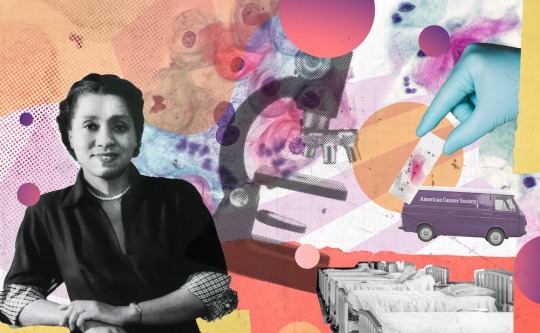
A Collage Featuring Dr. Helen Octavia Dickens, Hospital Beds, a Microscope, Cancer Cells, and a Van with the Words "American Cancer Society" on the side. Art by Colin Mahoney. Source images from the National Library of Medicine, National Museum of Health and Medicine, Wikimedia.
In 1926, 17-year-old Helen Dickens would sit in the front row of her pre med courses at Crane Junior College in Chicago. Dickens was a dedicated student, but her seating choice in a majority-white academic environment was strategic. “If other students wanted a good seat they had to sit beside me,” she recalled in an interview years later. “This way I didn’t have to look at them or the gestures made that were directed against me.” Dickens went on to become the one Black woman in her graduating class at the University of Illinois College of Medicine, where she met further bigotry with quiet determination. “Her frame of mind was, ‘I'll work through it,’” her daughter Jayne Henderson Brown, also a doctor, told American Experience. “Which she did. It didn't stop her.”
As Dr. Dickens was wrapping up her two-year obstetrics residency, she encountered the next hurdle to her childhood dream of practicing medicine: As a Black woman, white hospitals that employed female doctors didn’t want her, and hospitals serving the Black community hired only men. She was unsure where to go next until, one day, she read a notice on a bulletin board that changed the course of her professional life. It was a letter from Dr. Virginia Alexander, another young Black female doctor, looking for women to join her practice. Alexander ran the Aspiranto Health Home as an alternative birthing center out of her three-story row house in Philadelphia, using her living room as the waiting room and her dining room for treatment. Expectant mothers—some of whom were Black and impoverished, and without other access to care—came to Alexander’s home and received unusually long postpartum care and access to birth control.
Aspiranto was “community service in private practice,” Alexander wrote to Dickens, a “socialized practice of medicine.” Dickens went to Philly, and one year after her arrival took over the home altogether at age 27. The principles behind Aspiranto would guide the way she practiced medicine for the rest of her career. “Alexander helped Dickens to formulate a consciousness around how healthcare could be used as a site of activism,” said Dr. Amina Shakir, who wrote her dissertation about Dickens.
In many ways, Dickens’s background had already primed her to be community-conscious. Her father, Charles, had been born into slavery before escaping and teaching himself to read; he passed when Helen was only eight. “I know when he died,” Dickens later told an interviewer, “he had mortgaged our house to help build a Black meeting hall.” Her father’s death resulted from an infection after a tooth extraction—antibiotics didn’t yet exist—and yet when Dickens was 12, she talked to the family dentist about the possibility of going into medicine. Her father had wanted her to be a nurse, “[b]ut somewhere along the way,” she said, “I decided that if I was going to be a nurse, I might as well become a doctor.”
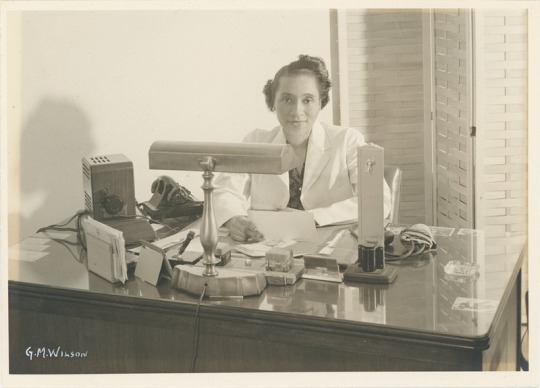
Dr. Helen Octavia Dickens at her desk. Image courtesy Jayne Henderson Brown.
Over the next seven years of her directorship of Aspiranto, she got the community interaction that she’d always wanted. “It was very exciting,” Dickens remembered of her time leading the birthing center. “You were going into the homes. You were seeing all these people. You were taking responsibility for care of people.” And as one of the first Black female doctors in the city, Dickens saw firsthand the inequity of the healthcare system and the extent to which medicine often marginalized Black women. She dedicated the rest of her life to bringing the best and newest models of care to her own community.
That dedication, during the next chapter of her career, involved getting as many Black women as possible to take a brand new medical test: the pap smear. The test’s namesake was Dr. George Papanicolaou, a Greek immigrant physician who with his wife and lab technician Mary worked for decades to document its efficacy in detecting cervical cancer, then the highest-killing cancer for women. Before the pap smear, cervical cancer was detected by biopsy, which often meant it was too late to treat the disease. “By the time you have symptoms, there's already a mass,” Dr. Henderson Brown explains. “It's already metastasized—liver, lung—and it kills. So the earlier it is detected, the easier it is to prevent the spread.” Dickens, who by the early 1950s had become the first African American board-certified OB/GYN in Philadelphia, proselytized the pap smear’s potential to save her patients’ lives.
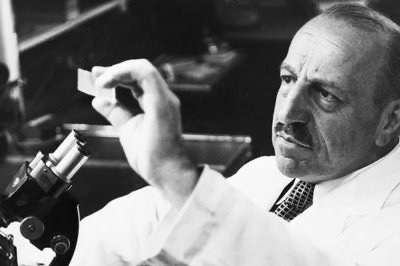
Dr. George Papanicolaou Pioneered the Lifesaving Cervical Cancer Screening that now Bears his Name.
First, though, she had to get beyond their historically well-earned distrust of gynecological treatment. The legacy of experimentation and forced sterilization of Black women made them wary of receiving care. “A lot of women are reluctant to get medical checkups that include pelvic exams,” she told the Philadelphia Evening Bulletin—which meant Dickens had to bring the test to them. She did so through clinics and workshops at Black churches; in later years, Dickens even provided free pap tests out of a mobile unit, parking an American Cancer Society van in church parking lots. Dickens also got the National Institutes of Health to fund a program to train other doctors to perform pap tests. “But she doesn't just stop there,” Shakir adds. “She also uses her work to provide statistics on Black women patients for the first time…She's really a forerunner. We take this for granted today because of the ways in which we use patient data.”
Dickens continued her crusade of improving Black women’s medical access in a variety of ways. After joining the faculty of the University of Pennsylvania’s School of Medicine in 1965, she pioneered a program for pregnant teens. And as the university’s dean for minority affairs, Dickens recruited other potential doctors from underserved communities, as she herself had once been.
All of this work she did matter-of-factly. It was, says Dr. Shakir, “her unrelenting way of making sure that the dignity and humanity of Black women was respected.” Or as her daughter notes, “I meet people all the time who say, ‘your mother delivered me’ or, ‘we really loved your mother.’ So I think her legacy is the gift she gave of healthcare to every woman who came within 10 feet of her.”
#American 🇺🇸 Experience#The Cancer Detectives#Article#Dr. Helen Octavia Dickens#Helen Dickens | The Crusader | Cancer Van | Against Cancer#Kirstin Butler#Dr. George Papanicolaou#Pioneered | Lifesaving Cervical Cancer Screening
0 notes
Text
Cervical Cancer: 5 Early Warning Signs!
Cervical cancer is a highly preventable disease when identified and treated early. This article is titled: Cervical Cancer: 5 Early Warning Signs! empowers women with knowledge about five key warning signs to watch for, explores the causes of cervical cancer, and provides actionable prevention tips, all backed by scientific evidence. Cervical Cancer: 5 Early Warning Signs! What is Cervical…

View On WordPress
#Cervical cancer awareness#cervical cancer causes#cervical cancer prevention#Cervical cancer symptoms#Early detection#early signs of cervical cancer#Warning signs#Women&039;s health
0 notes
Text
When it comes to your physical well-being, knowing for sure everything’s fine is always better than assuming. Unfortunately, too many women pass on the opportunity to guarantee a clean bill of health, consequently allowing small, manageable conditions to spiral into serious and even life-threatening complications. This Cervical Cancer Awareness Month, learn how routine screening can help stop the spread of cervical cancer and ensure many more happy and healthy years on the Culbertson Connects Health Blog!
1 note
·
View note
Text
Cervical Cancer Symptoms: Unveiling Early Warning Signs and Risk Factors
Cervical cancer is a recent threat that has been affecting thousands of women worldwide. Despite such advancement in medical science early detection still remains important in the successful treatment of this disease. Hence it becomes crucial to Understand the symptoms of cervical cancer to get timely medical attention, increasing the chances of successful recovery. Let us know the Symptoms of…

View On WordPress
#WriteAPageADay#Cancer Awareness#Cervical Cancer#Early Detection#Gynecological Cancer#Health Education#HPV#Pap Smear#Silent Symptoms#Women&039;s Health#Women&039;s Wellness
0 notes
Text
I think we need to talk about gynecological exams more like dental work than just getting a vaccine, you know what I mean? Like, validate people’s fears and concerns so people will be more open to care. Getting an IUD isn’t just ‘a little pinch’, getting a pap smear does feel violating and deeply uncomfortable. It’s okay to be afraid, it’s okay to need someone in the room with you or to need to pre-game with anxiety meds. You’re not weak if you feel that receiving gynecological care is more emotionally and physically taxing on you than other people.
You need to get that root canal to prevent an abscess in your jaw that could turn to full body sepsis. You need to get that pap smear to detect cervical cancers and viral infections that could lead to serious illness or death.

19K notes
·
View notes
Text

"Recognizing Blood Cancer: Unusual Symptoms to Watch For"
A form of cancer known as multiple myeloma develops in plasma cells, a subset of white blood cells that aid in the body's defense against infections by producing antibodies. It is typified by the unchecked proliferation and build-up of aberrant plasma cells in the bone marrow, which can displace good blood-forming cells and obstruct the generation of platelets, red blood cells, and white blood cells. blood cancer symptoms These aberrant cells also generate a lot of M protein, or monoclonal protein, a particular class of antibody. A thorough strategy that takes into account imaging data, laboratory results, clinical symptoms, and bone marrow analysis is necessary for the diagnosis of multiple myeloma. After a diagnosis, the patient's condition and the degree of the disease involvement can be used to guide the staging and subsequent treatment planning.
0 notes
Text
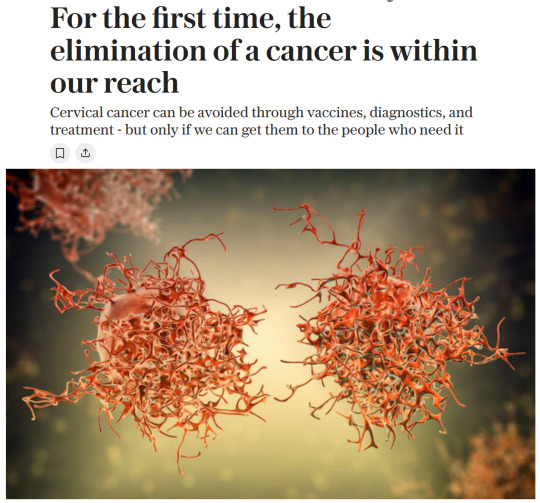
Article
"Every year, over 350,000 women die from cervical cancer and another 660,000 are diagnosed. [Note: Plus trans men and other trans people with a cervix.] As a consequence, children are orphaned, families impoverished and communities diminished by the loss of mothers, wives, daughters and sisters.
And yet, unlike most other cancers, almost all these cases and deaths can be averted. We have powerful vaccines that can prevent infection with the human papillomavirus (HPV) that causes cervical cancer; we have diagnostics to detect it early; and we have treatments for those it strikes. With these tools, cervical cancer can not only be stopped; it could become the first cancer to be eliminated. Some high-income countries are already close to elimination, meaning fewer than four cases per 100,000 women.
But in many low- and middle-income countries, these tools are still not available, which is why 94% of cervical cancer deaths occur in those countries.
In 2018, WHO launched a global call to action to eliminate cervical cancer, which was followed in 2020 by the adoption by all 194 WHO Member States of a Global Strategy to Accelerate the Elimination of Cervical Cancer as a Public Health Problem. The strategy calls for countries to achieve three targets by 2030: 90% of girls fully immunised against HPV; 70% of women receiving timely screening; and 90% of those found with precancer or cancer accessing treatment.
These targets are not just aspirational, they are achievable, even in low- and middle-income countries. Bhutan has already reached the targets, the first to do so in the South-East Asia region.
Since introducing the HPV vaccine in 2011, Rwanda has reached vaccine coverage of 90%, and today announced its national goal to reach the 90-70-90 targets three years ahead of schedule, by 2027. Already, in two districts – Gicumbi and Karongi – Rwanda is meeting those goals. Nigeria, which introduced the HPV vaccine in October last year [2023], has already vaccinated 12.3 million girls.
We have the tools and the opportunity to eliminate cervical cancer.
Since WHO issued the global call to action in 2018, more than 60 countries have introduced the HPV vaccine into their immunisation programmes, bringing the total to 144 countries that are routinely protecting girls from cervical cancer in later life. With scientific advances, we can now prevent cervical cancer with just a single dose, which 60 countries are now doing.
The largest provider of HPV vaccines to low- and middle-income countries is Gavi, the Vaccine Alliance, which plans to vaccinate 120 million children between now and 2030. But this plan requires that investments in health are sustained. We are also counting on manufacturers to confirm and honour their commitments to provide HPV vaccines to low- and middle-income countries in the coming years, to avoid the supply constraints that held back progress in the past.
But we cannot rely on vaccines alone. The impact of the rapid scale-up in vaccinating girls now will not be seen for decades, when they reach the adult years when cervical cancer typically appears. To save lives now, we must match the increase in vaccination with increases in screening and treatment.
Decades ago, as more women gained access to pap smears in developed countries, the mortality associated with cervical cancer dropped rapidly. Today, even better tests are available. Over 60 countries now include high-performance HPV tests as part of their screening programs. Women can even collect their own samples for HPV testing, removing more barriers to life-saving services. In Australia – which is on track to become one of the first countries in the world to achieve elimination – more than a quarter of all screening tests are now done this way...
Several countries are also investigating the use of artificial intelligence to enhance the accuracy of screening in resource-limited settings. When women are found with precancerous lesions, many are now treated with portable battery-powered devices, which can be operated in remote locations."
-via The Telegraph, November 18, 2024. Article written by Dr Tedros Adhanom Ghebreyesus, Director-General of the World Health Organization (WHO).
#cancer#cw cancer#fuck cancer#vaccines#hpv#cervical cancer#women and girls#vaccines work#public health#world health organization#womens health#healthcare#pap smear#obgyn#cancer treatment#cancer awareness#good news#hope
1K notes
·
View notes
Text
Cervical Cancer Awareness Drive at Jamshedpur School
Inner Wheel Club educates students on prevention and early detection Inner Wheel Club of Jamshedpur East organized a cervical cancer awareness program for students at Project Girls High School. JAMSHEDPUR – The Inner Wheel Club of Jamshedpur East conducted a cervical cancer vaccination awareness event at Project Girls High School, where they provided young women with information on prevention…
#आयोजन#cervical cancer prevention education#cervical cancer vaccination program#community cancer prevention#early detection awareness#Event#Inner Wheel Club health initiative#Jamshedpur cervical cancer awareness#Jamshedpur school health outreach#Project Girls High School health program#student health education#women&039;s health awareness Jamshedpur
0 notes
Text
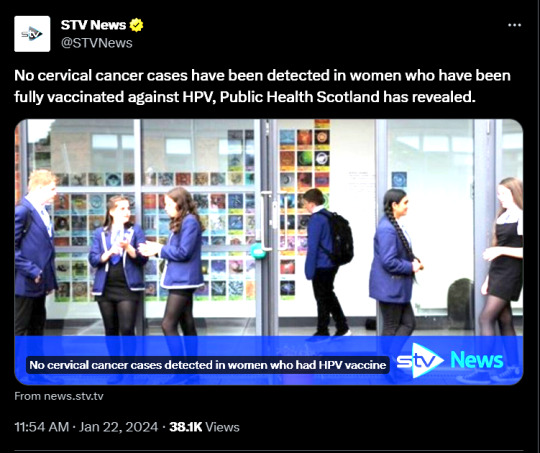
An absolutely phenomenal stat.
Public Health Scotland: No cervical cancer cases have been detected in women who have been fully vaccinated against HPV. The HPV jag was rolled out to girls aged 12-13 in Scotland in 2008.
3K notes
·
View notes
Note
quick question about pap smears — if they’re meant to detect cervical cancer and cervical cancer is caused by hpv, if ive had the hpv vaccine are pap smears still necessary?
hey so you know how people who get the flu shot can still get the flu? the HPV vaccine does not make you immune to cancer. according to the CDC, it does prevent about 90% of them, and countries with high rates of HPV vaccination have sharp drops in rates of cervical cancer, but that doesn't mean checkups aren't still important.
98 notes
·
View notes